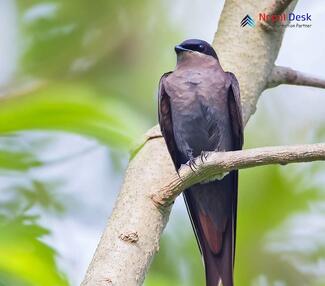Nestled among the breathtaking landscapes of Nepal are some truly remarkable wildlife species, and one such fascinating creature is the Asian Palm Swift (Cypsiurus balasiensis). It is a small swift bird well-known for its incredible aerial acrobatics and unique nesting habits, making them a captivating subject for birdwatchers and nature enthusiasts alike. It is very similar to the African palm swift, Cypsiurus parvus, and was formerly considered to be the same species. In this article, we will delve into the fascinating world of the Asian Palm Swift in Nepal and why these fascinating birds are worth further exploration.
Flight Skills Beyond Compare
One of the most striking characteristics of the Asian Palm Swift is its unrivaled mastery of flight. These small, swift birds possess relatively long, slender wings that allow them to maneuver effortlessly through the sky with seemingly boundless energy. They are rarely seen resting during daylight hours and spend most of their time airborne, hunting insects in mid-flight with pinpoint precision or darting between trees in search of shelter.
A Unique Nesting Affair
Another compelling aspect of the Asian Palm Swift is its distinctive approach to nesting. Rather than constructing elaborate nests in trees like many other bird species, these swifts make use of materials readily available in their natural habitat—primarily palm leaves. They use their saliva to attach these leaves together deftly, forming a simple yet sturdy nest that serves as protection against predators and harsh weather conditions.
Nepal: A Birdwatcher's Paradise
Nepal's diverse ecosystems host a wealth of bird species, with over 900 documented throughout the country. From dense forests to alpine meadows and marshlands, there's no shortage of remarkable habitats where bird enthusiasts can spot both native and migratory species. The Asian Palm Swift is particularly prevalent within the lowland regions of Nepal, adding an extra layer of allure for those passionate about avian diversity.
Conservation Efforts: Preserving the Beauty
As urbanization and habitat destruction continue to threaten the rich biodiversity of Nepal, conservation efforts become increasingly essential for the future survival of its bird species, including the Asian Palm Swift. Supporting local and international organizations committed to preserving these exquisite creatures and their habitats is a crucial part of ensuring their longevity and the well-being of Nepal's natural landscapes.
In Conclusion: Cherishing the Wonders
The Asian Palm Swift in Nepal is a prime example of the extraordinary beauty found within our natural world—a testament to the enchanting diversity of wildlife that graces our planet. As we continue to marvel at these captivating birds, let us remember our responsibility to protect and care for them by fostering awareness and supporting conservation initiatives.




